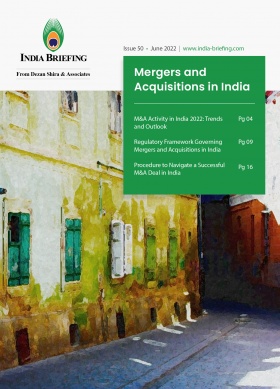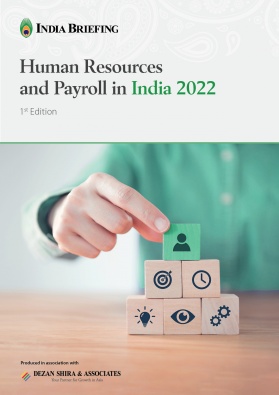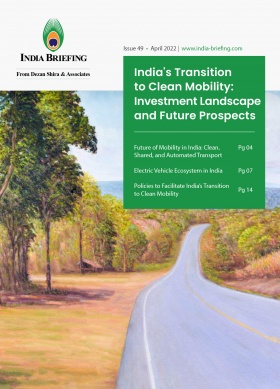Opportunities and Headwinds in India’s Domestic Aviation Industry
India is among the world’s fastest growing aviation markets but its domestic industry is confronting multiple challenges in the near term. The growth of the industry not only represents opportunities for airlines, but for a whole range of companies serving the sector, including those involved in the maintenance, repair, and overhaul of aircrafts.
India is the world’s fourth largest aviation market, behind the US, China, and the UK. It’s a nation of 1.3 billion people, with a growing middle class and an increasing need to enhance regional interconnectivity between states and cities while expanding global links.
Despite the pandemic slowing demand for air travel, particularly in East Asia, India’s civil aviation industry has emerged as one of the fastest growing indigenous sectors in recent years. In fact, this growth means that India will likely overtake the UK to become the third largest air passenger market by 2024.
India has a very competitive civil aviation sector, with numerous airlines looking to increase their market share ahead of a predicted boom in regional air travel. But there are also opportunities for international growth. In fact, Indian airlines were recently presented with a unique opportunity to enhance international market share as domestically registered airlines still enjoy access to valuable Russian airspace. Airlines from many Western and US-aligned nations have had their rights to access Russian airspace rescinded after condemning Moscow’s war in Ukraine.
The India Brand Equity Foundation (IBEF) contends that the aviation industry will contribute nearly US$500 billion to the Indian economy, through travel and tourism, in 2028 alone. India’s growing demand for air travel creates not only opportunities for airlines, but for maintenance, repair, and overhaul (MRO) operations and other contributing sectors.
Market size and growth
The aviation industry is much larger than it may appear on the surface. In 2018, the Air Transport Action Group (ATAG) stated that the global air transport sector supports 65.5 million jobs and US$2.7 trillion in global economic activity. Over 10 million people work directly for the industry itself, the organization highlighted.
The group also claims that aviation jobs are, on average, 4.4 times more productive than other jobs in the economy. The industry supports businesses and the development of other sectors such as tourism.
The industry creates millions of jobs on the ground in a variety of interconnected sectors, from air traffic control to airport management and MRO. However, demand for passenger air travel and trade are the key drivers of the industry.
Passenger travel in India
Demand for air travel is growing in India, and there are a few reasons for this beyond its burgeoning population. The nation has a rising working population and widening middle-class demography that is expected to boost demand. In recent years, growth in demand has consistently outpaced the growth in supply, resulting in high utilization. India’s domestic traffic makes up 69 percent of the total airline traffic in South Asia, according to data from PRS Legislative Research.
Delhi’s Indira Gandhi International Airport is currently the ninth busiest airport in the world, according to OAG data, which uses a metric based on scheduled airline capacity for the month. The country’s other major airports include those in its metropolitan hubs Mumbai, Chennai, Bengaluru, Kolkata, and Hyderabad.
The number of passengers traveling through India’s largest airports increased substantially prior to the pandemic. Delhi airport saw 48 million passengers in 2016, and this grew to 69 million in 2019. A similar increase can be seen elsewhere in the country, with Kolkata passengers increasing from 12 million in 2016 to 22 million 2020.
Air freight in India
According to ATAG, air travel carried 35 percent of world trade by value (US$6.0 trillion) in 2017, but less than one percent by volume (62 million tons). As India’s economy develops, so does demand for international trade and air freight.
From FY 2016 to FY ‘22, the volume of India freight traffic increased at a CAGR of 2.52 percent. However, the growth rate in the years leading up to the pandemic was substantially higher. Domestic air freight volumes are still below pre-pandemic levels.
Neither freight or passenger traffic is yet to reach pre-pandemic levels as Covid-19 continues to impact demand, trade, incomes, as well as supply chains across India and around the world.
Investment and supply growth
Airports
Airports are crucial links in the air transport value chain. India envisages the number of operational airports rising to 190-200 by 2040 as aviation demand rises across the country. Figures differ, although it is understood that the Airports Authority of India (AAI) currently manages 137 airports today, while the government contends that only 68 airports have been operationalized for the Regional Connectivity Scheme. New Delhi wants to operationalize 100 airports by 2024 in an effort to augment land and sea infrastructure.
India’s airport capacity is expected to handle one billion trips annually by 2023, according to PRS Legislative Research.
Prior to 2013, AAI was the only major player involved in developing and upgrading airports. However, that has all changed, and there has been increased government and private participation. The Government of India is currently supporting the development of 19 airports, seven of which are through Public-Private Partnerships (PPP). The government contends that the Regional Connectivity Scheme seeks to facilitate/stimulate regional air connectivity by making it affordable.
The below table notes some of the top private sector players in airport development in recent years.
|
Company |
Investment |
|
GMR Group |
Development of Hyderabad International Airport. Modernization of Delhi International Airport |
|
GVK |
Modernization of Mumbai International Airport |
|
Siemens |
Development of Bengaluru International Airport |
|
L&T |
Development of Navi Mumbai International Airport |
|
Adani |
Development of Ahmedabad and Thiruvananthapuram Airports |
The IBEF contends that investment to the tune of INR 420-450 billion (US$5.99-6.41 billion) is expected in India’s airport infrastructure between FY 2018-23, although this figure has likely been lowered due to the pandemic.
Foreign investment in new initiatives, including airlines, is allowed up to 49 percent under the automatic route. Up to 100 percent would be permitted in scheduled air transport service, regional air transport service, and domestic scheduled passenger airline, but government approval is required first.
Airlines
In 2021, India’s domestic airlines had just over 700 planes in service. However, this number is expected to grow in the coming years. In fact, the number of airplanes is expected to reach 1,100 by 2027.
One reason for this is the entry of new players into the market. Akasa Air is one of three new airlines to set up in India over the past decade. The majority of these new airlines have adopted a low-cost approach, hoping to appeal to price-sensitive flyers using low fares and unbundled services. Akasa Air – which was founded by the Indian billionaire Rakesh Jhunjhunwala – flew its first flight service from Mumbai to Ahmedabad on August 7, 2022 – and will compete with budget carriers IndiGo, SpiceJet, and GoFirst. However, Akasa Air’s network strategy intends to connect metro cities with smaller towns across India.
MRO
India’s MRO sector is expected to develop in tandem with the passenger and freight industry. According to the IBEF, the MRO industry is likely to be worth over US$2.4 billion by 2028, up from US$800 million in 2018.
Last year, the government announced a new policy with the aim of attracting MRO investment and eventually making India a global MRO hub. Land allotment for MRO facilities will be leased for 30 years instead of three-five years, as was the case under the previous terms.
India’s share of the US$80 billion global MRO market is only at 2.5 percent at present.
Headwinds
India’s civil aviation sector has seen considerable change in recent years, and the pandemic served only to reduce the addressable market size – although there is clearly a sizeable future market and airlines are keen to enhance their market share as more demand comes online. However, debt and safety challenges are two of the biggest issues facing the sector.
Airlines, notably those with high debt burdens, struggle to maintain the required safety standards. Debt is an issue for India’s airlines with the pandemic causing nearly three years of reduced flying.
In late 2021, the Indian government agreed to clear all of Air India’s debts owed to banks, oil companies, airports, and aircraft lessors by the end of this financial year. This paved the way for the Tata Group to make a winning bid of INR 180 billion to buy Air India, Air India Express, and Air India SATS Airport Services Pvt Ltd. through its subsidiary Talace Private Limited. (Tata Sons is now making moves to integrate Air Asia with Air India. The Tata Group had raised their stake in Air Asia to 83.67 percent in December 2020. The Indian conglomerate also own Vistara Airlines.)
Other airlines in India have not been as fortunate as Air India to have their debts cleared by the government; it now remains to be seen how the airline turns its fortunes around after returning to the Tatas from a beleaguered state stewardship.
Meanwhile, indicative of the state of India’s aviation market, a Times of India article from late July, 2022, claimed that IndiGo was the only financially stable operator of regional flights using turboprops in the country.
Many airlines were already suffering financially before the COVID-19 pandemic struck – the pandemic cost airlines in excess of US$2bn and airports around US$500m according to PRS Legislative Research. Two airlines, Air Odisha Aviation Pvt Ltd and Deccan Charters Pvt Ltd, exited the market in 2020. Air India had reported losses for the past four years, while all other major private airlines in India, including market leaders IndiGo and Gurgaon-based SpiceJet, registered losses in 2018-19.
Some Indian airlines have also suffered from reputational challenges in recent years. Just last month, SpiceJet caused controversy after a number of air safety accidents angered the country’s aviation regulator and damaged customer trust. In early July, it was reported that the airline had recorded eight malfunction incidents in the previous 18 days.
However, India’s air safety record is positive compared to the global average. In 2019, there were just 0.82 accidents per million flights as compared to the global average of 3.02. This represents a considerable improvement from 2014, when there were 2.8 accidents per million flights in India.
But more generally, the reputation of India’s airline industry will be tested as India-based airlines enhance their services to international audiences. After all, air travel passengers are price sensitive to an extent, though this should not come at the cost of safety.
About Us
India Briefing is produced by Dezan Shira & Associates. The firm assists foreign investors throughout Asia from offices across the world, including in Delhi and Mumbai. Readers may write to india@dezshira.com for more support on doing business in in India.
We also maintain offices or have alliance partners assisting foreign investors in Indonesia, Singapore, Vietnam, Philippines, Malaysia, Thailand, Italy, Germany, and the United States, in addition to practices in Bangladesh and Russia.
- Previous Article How Should India Read Escalating China-Taiwan Tensions
- Next Article India’s 5G Spectrum Auction: A Look at the Bids and Commercial Roll-Out








